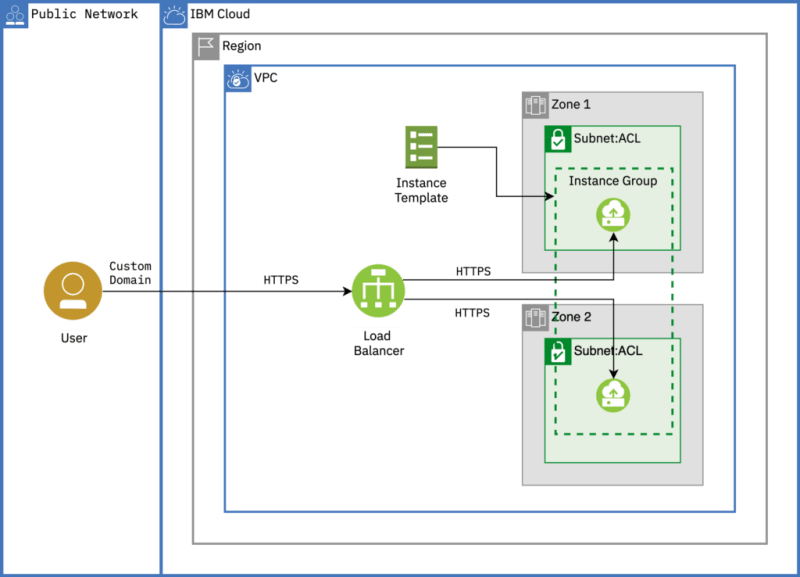Learn how to provision and auto scale VSI on VPC using Terraform scripts and explore auto scale scenarios like SSL termination (offloading) and end-to-end encryption.
With Auto Scale for VPC, you can create an instance group to scale according to your requirements. Based on the target utilization metrics that you define, the instance group can dynamically add or remove instances to achieve your specified instance availability.
Let’s start with a quick one, like an introduction to VPC.
What is a VPC?
A virtual private cloud (VPC) is a public cloud offering that lets an enterprise establish its own private cloud-like computing environment on shared public cloud infrastructure. The following video gives more information on VPCs:
Auto scaling on VPC
With Auto Scale for VPC, you can improve performance and costs by dynamically creating virtual server instances (VSIs) to meet the demands of your environment. You set scaling policies that define your desired average utilization for metrics like CPU, memory, and network usage. You can create an instance group in your IBM Cloud VPC to auto scale according to your requirements by using the IBM Cloud console. Based on the target utilization metrics that you define, the instance group can dynamically add or remove instances to achieve your specified instance availability.
What’s the outcome?
Following the instructions and executing the Terraform scripts, you will provision the following:
- A VPC
- Two subnets — one in each zone (zone 1 and zone 2) — Configure in main.tf file
- One VSI in subnet-zone-1 (to start with)
- Load balancer (backend pool and frontend listener)
- Instance group using an instance template
- Instance group manager with a scaling policy (CPU utilization) attached to the instance group
Pre-requisites
- IBM Cloud IAM API key (refer to the IAM documentation)
- SSH key (refer to the VPC SSH documentation)
- If you want to enable SSH offloading (termination) or end-to-end encryption , you need to create a Certificate manager service, order a certificate, and pass that to load balancer HTTPS listener. Follow the instructions here to learn the certificate ordering process.
Step-by-step instructions
- Clone the vpc-tutorials GitHub repository and move to the vpc-autoscale directory:
git clone [https://github.com/IBM-Cloud/vpc-tutorials.git](https://github.com/IBM-Cloud/vpc-tutorials.git)
cd vpc-autoscale
- Copy the Terraform variables template:
cp terraform.tfvars.template terraform.tfvars
Update the values in the terraform.tfvars file based on your requirement and save the file. To understand the variables, refer to the variables.tf file.
Initialize the Terraform providers by running the following:
Execute the Terraform plan:
terraform planApply the Terraform plan:
terraform apply
The max_membership_count to scale is set to 5, the aggregation_window is set to 90 secs, and cooldown is set to 120 secs. You can change these values in the main.tf file. Refer to the Instance-group-manager Terraform provider documentation.
SSL offloading (termination)
For all incoming HTTPS connections, the load balancer service terminates the SSL connection and establishes a plain-text HTTP communication with the backend server. CPU-intensive SSL handshakes and encryption/decryption tasks are shifted away from the backend servers, allowing them to use all their CPU cycles for processing application traffic.
End-to-end encryption
In this section, you will enable end-to-end encryption by creating a self-signed certificate in the VSI. You will use the SSL installation script — install-software-ssl.sh.
Clean-up
Run the following command to delete the resources you created. The action is irreversible:
terraform destroy
Terraform-as-a-Service
With IBM Cloud Schematics, you can simplify the above Terraform experience. Schematics delivers Terraform-as-a-Service so that you can use a high-level scripting language to model the resources that you want in your IBM Cloud environment and enable Infrastructure as Code (IaC).
Refer to this post to understand how Schematics works with an example.
What’s next?
How about automatically assigning a floating IP to a newly created VSI by monitoring Activity Tracker events and using Cloud Functions to interact with the VPC API? Yes, you can achieve this by following the instructions in this post: “ Extend VPC Resources with Cloud Functions, Activity Tracker with LogDNA, andSchematics.”
Explore other VPC scenarios
There are additional scripts in the vpc-tutorialsrepo that are used to set-up scenarios for VPC tutorials and to clean up VPC resources:
Questions and feedback
If you have feedback, suggestions, or questions about this post, please reach out to me on Twitter @VidyasagarMSC or use the feedback button on the tutorial to report a problem on its content. You can also open issues.
The tutorials section has a feedback form on the side where you can comment on the content. If you have suggestions on the existing tutorials or ideas for future additions, please submit your feedback.
Originally published at https://www.ibm.com on October 21, 2020.










Top comments (0)